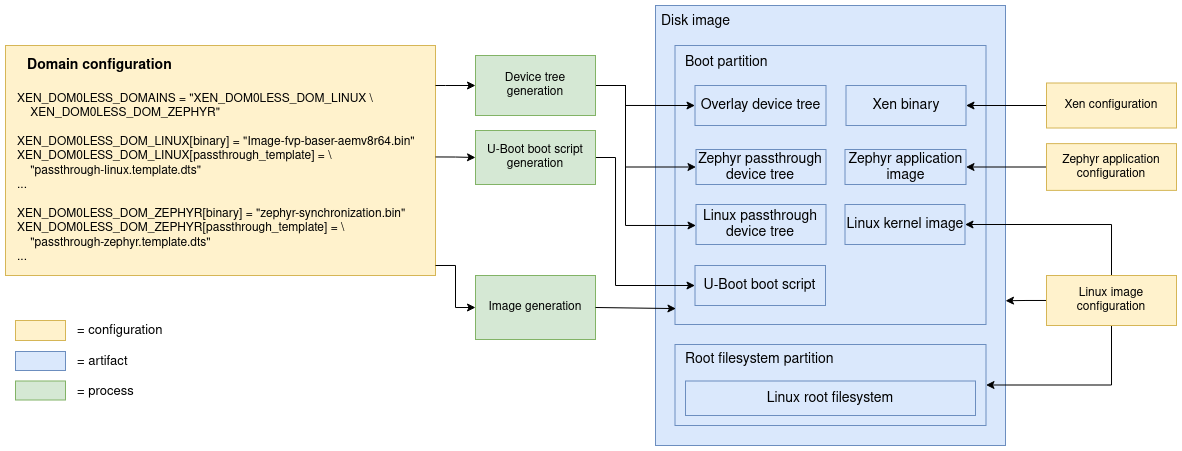Armv8-R AArch64 Extras Layer (meta-armv8r64-extras)
Zephyr Sample Applications
This Software Stack supports four Zephyr sample applications:
zephyr-helloworld
zephyr-synchronization
zephyr-philosophers
zephyr-rpmsg-demo (Zephyr part of RPMsg Demo)
Recipes for zephyr-helloworld, zephyr-synchronization and
zephyr-philosophers are provided by meta-zephyr. Source code for these
three sample applications are provided by Zephyr, with extra configuration
provided for zephyr-philosophers by file
meta-armv8r64-extras/dynamic-layers/zephyrcore/recipes-kernel/zephyr-kernel/zephyr-philosophers.bbappend.
These three applications can work in both the baremetal stack and the
Virtualization stack.
The zephyr-rpmsg-demo application works in the Virtualization stack only. It
comes from the recipe
meta-armv8r64-extras/dynamic-layers/virtualization-layer/recipes-kernel/zephyr-kernel/zephyr-rpmsg-demo.bb.
This application works as a RPMsg host (rpmsg-host) in the Zephyr domain,
and co-works with the RPMsg remote application (rpmsg-remote) running in the
Linux domain to implement the Inter-VM communication through the RPMsg
protocol. Recipe for the rpmsg-remote application is provided by
meta-armv8r64-extras/dynamic-layers/virtualization-layer/recipes-demo/rpmsg-demo/rpmsg-demo.bb,
which along with zephyr-rpmsg-demo.bb is provided by this Software Stack.
The source code is also provided by this Software Stack and can be found in
directory components/apps/rpmsg-demo. For more details, see
RPMsg Demo under Demo Applications.
Running Zephyr applications is supported by the runfvp script from
meta-arm. Section Build and Run has examples that uses this script.
Virtualization Stack
The Virtualization stack uses Xen as the Type-1 hypervisor to boot one or more domains independently. The meta-virtualization layer is used to provide Xen build support.
The Xen MPU implementation only supports “dom0less” mode (for more details see the Hypervisor (Xen) section), so the meta-armv8r64-extras layer provides logic to build the required dom0less artifacts, which are shown in the diagram below. For more information on how U-Boot detects and uses these artifacts at runtime, see the U-Boot Boot Sequence.

Domain Configuration
The default domain configuration is provided in a bbclass. For more information, see Customizing the Xen Domains.
Xen Configuration
Xen is configured through the .bb and .bbappend files in directory
meta-armv8r64-extras/dynamic-layers/virtualization-layer/recipes-extended/xen,
which define the branch and revision to build for the fvp-baser-aemv8r64
machine and also includes a machine-specific config file.
Linux Image Configuration
In projects based on OE-core, the Linux image recipe is responsible for creating
the disk image, including the root filesystem partition. The boot partition,
which is part of the same disk image, is populated by extending
IMAGE_CLASSES (see Image Generation below).
No changes are made to the Linux kernel for the Virtualization use case.
Zephyr Application Configuration
Zephyr requires some specific configuration when running as a Xen domain on the
fvp-baser-aemv8r64 machine. It is necessary to match the number of CPUs
allocated, the DRAM address and the selected UART with the equivalent parameters
in the domain configuration. This is achieved using Xen-specific overlay files
(see Customizing the Zephyr Configuration).
Device Tree Generation
Xen domains in dom0less mode are configured using additions to the /chosen
node in the device tree. To avoid modifying the firmware’s device tree for the
Virtualization stack we instead dynamically generate a device tree overlay file
which can be applied at runtime by U-Boot. Additionally, in order for Xen to
access peripherals in dom0less mode, we must specify which peripherals to “pass
through” to each domain using a domain-specific passthrough dtb file (see
https://xenbits.xen.org/docs/unstable/misc/arm/passthrough.txt for more
details).
All these device trees are created from templates, substituting placeholders with values defined in the domain configuration. The passthrough device tree template to use for each domain is selected in the domain configuration.
U-Boot Script Generation
The boot script is partially dynamically generated in order to load the configured domain binaries and passthrough device trees to the configured memory addresses prior to booting Xen.
Image Generation
The boot partition needs to be populated with the artifacts necessary to boot
Xen and its domains so they can be loaded by U-Boot. This is achieved using a
custom Wic image and a custom bbclass (xen_image_dom0less). This class can
be added to IMAGE_CLASSES so that the desired Linux image recipe
(e.g. core-image-minimal) includes the necessary configuration to populate
the boot partition.